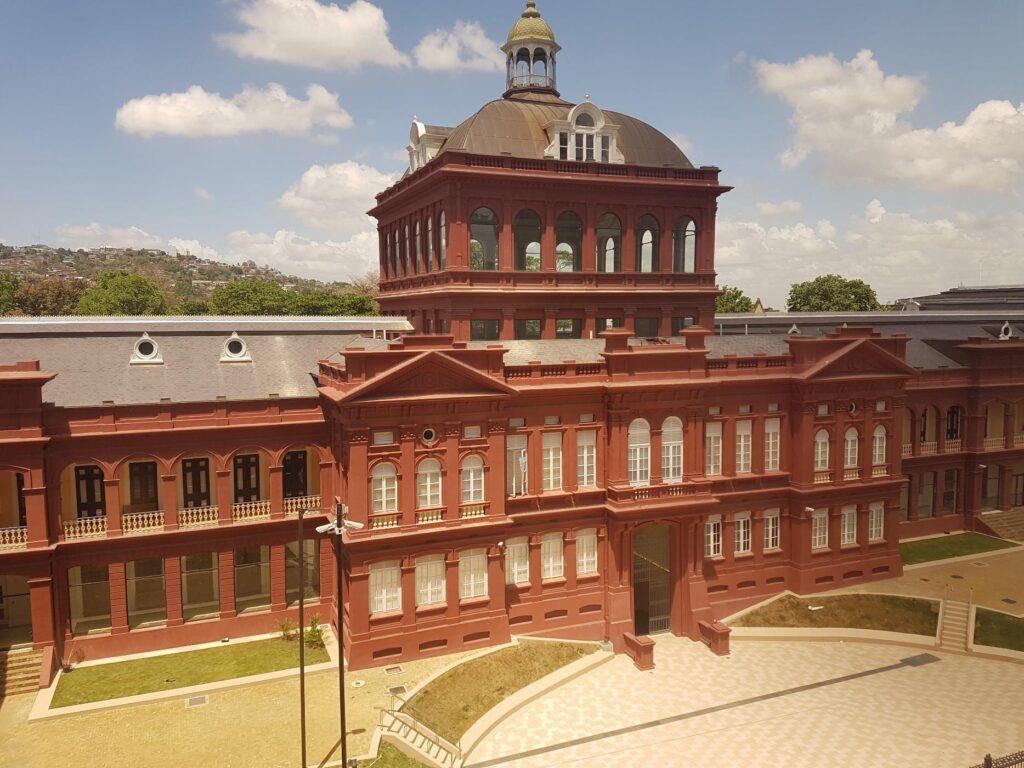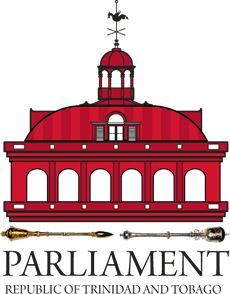
In the year 1808, Port-of-Spain was destroyed by fire. At that time, it was a sprawling town of wood and shingle, which had grown tremendously during the previous twenty-five years.
As a result of this disastrous fire, Government brought in legislation with regard to building regulations, and for this reason the new government buildings, all of which had been destroyed by the fire, were built of brick.
Foundation Laid
On the 15th February, 1844 the Governor, Sir Henry McLeod, laid the foundation stone for a new block of government buildings, on a site on the west side of Brunswick Square (now Woodford Square). The land belonged to a group of eight persons. The architect was Mr. Richard Bridgens, Superintendent of Public Works, while the buildings comprising two main blocks, north and south, were to be connected by a double archway, much as the Red House of today, but on a smaller scale. The double archway was a feature required by the City Council to keep Prince Street open, as the building was built over it, with the stipulation that it should never be closed to the public, and through which pedestrians and wheeled traffic passed freely. Though incomplete, the southern wing, containing the law courts, was opened in 1848 and a month later the Council Chamber was formerly inaugurated with much ceremony by Lord Harris, after an impressive ceremony in Trinity Cathedral.
To quote from the Port-of-Spain Gazette of 1892:
“Nothing further had been done to complete the buildings since their erection some fifty years ago. The only attempt to relieve the monotony of the whole is to be seen in the arching of the carriageway through the courtyard which is a perfect skeleton and, like the ruins of Pompeii, is more suggestive of what the buildings must have been than of what they were intended to be.”
The urgent need for a proper record office arose, and the plans proposed by the Director of Public Works, Mr. J. E. Tanner, showed that two new buildings of two storeys each, were to be erected at the southern corners of the northern building, and two similar structures on the other side of the carriageway, abutting the Court House or southern building. One of these was to become the office of the Registrar and the other, the Record Office. These and many other additions, alterations and ornamentations were carried out at a cost of £15,000.
1903 Fire
In 1897, as Trinidad was preparing to celebrate the Diamond Jubilee of Queen Victoria, the buildings were given a coat of red paint, and the public promptly referred to them thereafter as the Red House. This direct ancestor of our present Red House was burnt to the ground on the 23rd March, 1903, during the Water Riots. On the day of the fire, while the new Ordinance regarding the distribution of and payment for water in the town was being debated in the Legislative Council, a protest meeting was held in Brunswick Square by the Ratepayer’s Association, as there was much public dissatisfaction over certain clauses contained in the Ordinance which increased the water rates. At the end of the meeting, the crowds became noisy and stones were thrown, and all the windows of the Red House were smashed including a stained glass window in the chamber which was erected to commemorate the arrival of Christopher Columbus in Trinidad. When a woman was arrested by a policeman, the mob immediately became riotous. Stones were thrown into the Council Chamber and the Members were forced to protect themselves under tables and desks and behind the pillars. Still, the Governor, Sir A.C. Maloney, refused to withdraw the Ordinance. When it became known that the lower storey of the building was on fire, the riot act was read, following which the police opened fire on the crowd. Sixteen people were killed and forty-two injured, and the Red House was completely gutted. After the fire only the shell of the Red House remained.
Rebuilding
The work of rebuilding it began the following year, and the Red House, as we know it today, was erected on the same site. It was opened to the public on the 4th February, 1907, by Governor, Sir H.M. Jackson.
The building was designed and built by D. M. Hahn, Chief Draughtsman of the Public Works, at an estimated cost of £7,485. This sum included the “gesso” (plaster-of-paris mixture prepared with glue) work in the Legislative Council Chamber and the Justice Hall, which was estimated at £7,200.
The work was completed in 1906. The ceiling is the most striking feature in the Chamber. It is Wedgewood blue with white gesso work and was the work of Messrs. Jackson & Sons, an English firm.
The decorations were made in England in panels, and shipped to Trinidad in crates.
An Italian craftsman was sent to install the ceiling.
The entablature and dais at the eastern end were also designed by D. M. Hahn. The columns and entablature are made of purple heart wood, while the panelling is fustic (yellow tinted wood commonly found in South America). The passageway between the two buildings which replaced the double archway, is no longer open to vehicular traffic. The fountain in the centre of the rotunda was designed by D. M. Hahn as a means of cooling and ventilation for the offices, in the days before air-conditioning. The offices of the early Red House, with the exception of the Governor’s office and that of the Colonial Secretary, comprised offices for the Attorney-General, Registrar-General Lands & Surveys Department, Judges’ Chambers, the Courts of Justice and the Parliament and Law Libraries, as well as the Legislative Council Chamber, which is now the Parliament Chamber. At present, the building is being restored for the exclusive use of the Parliament.
The Red House today is the second Government building to be known by this name since the newly-constructed government offices were built on the same site and given the same name. The name Brunswick Square was changed to Woodford Square during World War I in 1914-1918. The rubble which was removed after the fire was used as landfill for Victoria and Harris Squares; so when you stroll through these public squares you may literally be walking on the history of the Red House.
Adapted from Mavrogodato, O.,The Red House in Voices in the Street
1990 to Present
On Friday July 27, 1990 at 6:05 p.m., armed gunmen stormed the Parliament Chamber where the House of Representatives was in session, taking the then Prime Minister, eight of his Cabinet Ministers and six other Members of Parliament hostage.
The Red House suffered gravely from this invasion since the building was shot at and even shelled. In the aftermath, bullet holes were visible on walls, doors, windows and the ceiling of the Chamber. There was a gaping hole at the southern end of the building on the ground floor, made by a B-300 weapon fired on the night of July 28.
Seven people were killed in the Red House as a result of the attack on the building:
- Roger George – Assistant Superintendent;
- Lorraine Caballero – Clerical Officer;
- Malcolm Basanta – Estate Policeman;
- Mervyn Teague – Government Broadcasting Unit employee;
- Arthur Guisseppi – Ex-policeman;
- George Francis – Chauffeur; and
- Solomon McLeod – Police Headquarters Sentry
Many more were injured. Mr. Leo Des Vignes, MP for Diego Martin Central, was shot and later removed to the hospital, where he died.
Clean-up efforts began after the six-day siege was over. For weeks after the litter, shattered glass, stained carpets and bloodstains were removed, a stench of death and a sense of tragedy remained.
The clean-up and restoration work was divided into three phases:
- the first phase was centered on the southern end of the Red House, where the former Supreme Court was housed;
- the second phase included the repainting and refurbishing of the building’s exterior and of the northern Chamber, and
- the third phase, which has not yet been completed is to include the complete restoration of the entire building. Along with these many changes came the closure of the pedestrian path through the Red House.
Eternal Flame
As a temporary measure, sittings of both the Lower and Upper Houses (two each) were held at the Auditorium of the Central Bank, but with the opening of the Fifth Session of the Third Parliament on November 5, 1990, sittings were once again held in the Red House, not at its customary place, but at the southern Chamber. It was not until July 26, 1991, that the traditional Chamber was restored to its original status, and Parliament reconvened in that Chamber with a rededication and memorial service, in which a commemorative plaque bearing the names of all those killed in and around the Red House, was unveiled. An eternal flame, symbolising “the need to be ever-vigilant in the protection of our democracy” was also lit outside. It stood atop the marble cenotaph on the eastern lawn and is inscribed with the Oath of Allegiance of Members of Parliament, the National Anthem, the Affirmation of the People and the names of the victims of the attempted coup. The Eternal Flame and marble cenotaph have now been permanently erected along the pedestrianised Knox Street.
Weather Vane
With the re-election of the People’s National Movement in 1992, the Red House became, once again, the center of controversy when a decision was taken to remove the resident sea serpent atop the building in order to replace it with a dove bearing an olive branch in its beak. The 20-pound dove, constructed out of copper, and painted white, designed by Ken Morris, was replaced on the night of January 11, 1992, and was timed with the ceremonial opening of the 1992 Parliamentary session.Today, the Red House still stands as the seat of the nation’s Parliament and as a symbol of fortitude and democracy for the people of Trinidad and Tobago.
Re-Opening of the Red House
In 2011 the Parliament left the Red House and moved to temporary accommodation in Tower D of the Port-of-Spain International Waterfront Centre, in order to allow for repair of the entire building for the exclusive use of the Parliament. On Friday 24th January, 2020 the Red House was re-opened by Her Excellency Paula-Mae Weekes, President of the Republic of Trinidad and Tobago. The number of staff at the Parliament had grown so significantly during that period that a companion building, Cabildo Chambers, located to the west of the Red House at St. Vincent Street, was needed to accommodate them. The buildings were joined by an elevated walkway to allow for access between both buildings.
